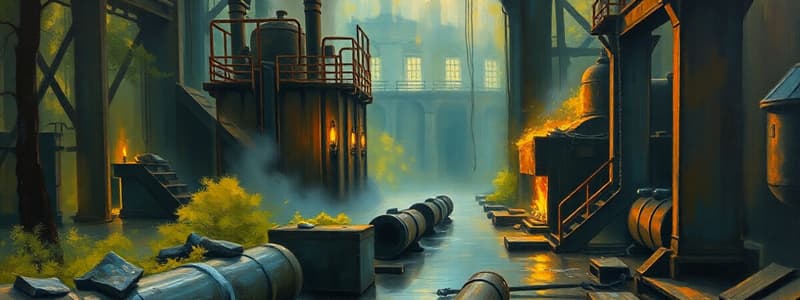Podcast
Questions and Answers
What is the main goal of the SALCOS project in Germany?
What is the main goal of the SALCOS project in Germany?
- To increase the efficiency of traditional blast furnaces.
- To develop new coal-based steelmaking methods.
- To completely eliminate steel production.
- To produce climate-neutral steel using hydrogen. (correct)
What strategy does the COURSE 50 project primarily focus on to achieve green steel production?
What strategy does the COURSE 50 project primarily focus on to achieve green steel production?
- Utilization of photovoltaic energy.
- Hydrogen reduction in blast furnaces and efficient CO2 capture. (correct)
- Increased use of recycled steel.
- Development of new alloy materials.
Which of the following technologies is the ULCOS Program investigating to reduce CO2 emissions?
Which of the following technologies is the ULCOS Program investigating to reduce CO2 emissions?
- Carbon capture from atmospheric air.
- Blast furnace with top-gas recycling. (correct)
- Hydrogen-powered vehicles.
- Enhanced oil recovery techniques.
What is Tata's target CO2 emissions reduction by 2030?
What is Tata's target CO2 emissions reduction by 2030?
What is the primary focus of ArcelorMittal's Hydrogen Research Program?
What is the primary focus of ArcelorMittal's Hydrogen Research Program?
Flashcards
SALCOS
SALCOS
A German project aiming for climate-neutral steel production using hydrogen.
Hydrogen Reduction
Hydrogen Reduction
Utilizing hydrogen as a reducing agent in steelmaking processes to decrease CO2 emissions.
Direct Reduced Iron (DRI)
Direct Reduced Iron (DRI)
A process for producing iron using natural or green hydrogen which later becomes either steel, components, or raw materials for steel manufacturing.
Green Steel
Green Steel
Signup and view all the flashcards
ArcelorMittal's Hydrogen Program
ArcelorMittal's Hydrogen Program
Signup and view all the flashcards
Study Notes
Steel Decarbonization Initiatives
- SALCOS (Germany): Aims for climate-neutral steel through hydrogen. Transition from blast furnaces to direct reduction, initially with natural gas, then hydrogen. Launched in 2015.
Japanese Steel Production Initiatives (Course 50)
-
Focus: Green steel production through hydrogen reduction in blast furnaces and CO₂ capture.
-
Hydrogen Reduction: Hydrogen is used as a reducing agent in blast furnaces, expected to decrease CO₂ emissions by 30% compared to conventional methods.
European Green Steel Production (ULCOS Programme)
-
Participants: 48 European companies collaborating on green steel production.
-
Research focus: Investigating technologies like blast furnace with top-gas recycling (TGR-BF) and new smelting reduction processes(HIsarna) to reduce CO₂ emissions.
Tata Steel (Netherlands) Decarbonization Plan
-
Goal: Reduce CO₂ emissions by 35-40% by 2030 and achieve carbon neutrality by 2045.
-
Methods: Replace blast furnaces with direct reduced iron (DRI) plants and electric arc furnaces (EAF).
ArcelorMittal's Hydrogen Research Program
-
Scope: Global decarbonisation of steel production through hydrogen-based technologies.
-
Technologies: Hydrogen-based direct reduction (DRI) to replace fossil fuels with green hydrogen in existing steel plants.
-
Timeline: Implementation of these technologies at an industrial level by 2025.
Studying That Suits You
Use AI to generate personalized quizzes and flashcards to suit your learning preferences.




